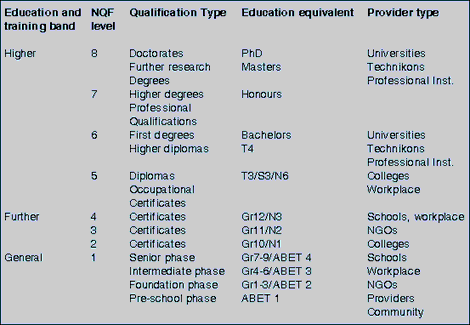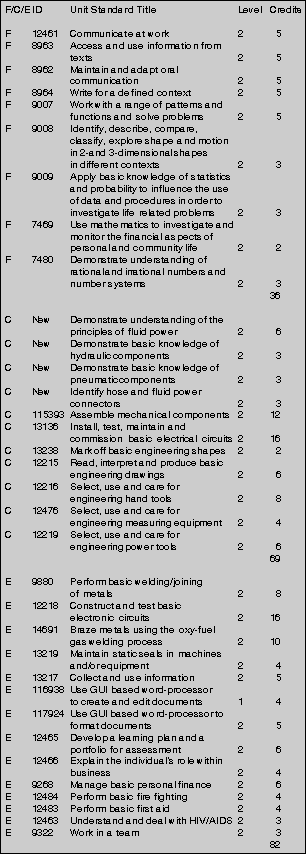
SAFPA has spent the last five years putting the structures in place for the National Certificate in Fluid Power qualification and completed this work in 2006. Work on the South African National Certificate in Fluid Power has been completed and submitted to MERSETA, which has subsequently submitted it to SAQA (South African Qualifications Authority) for approval and registration on the skills database. The SAQA consultative forum was scheduled to meet on 19 April and discuss the qualification. To date no news has been received of any further progress and SAFPA is frustratedly awaiting registration of the qualification and of the new unit standards by SAQA. The association has also put in place training courses for assessors of which one has been completed. This establishes the registered assessors to carry out the recognition of prior learning and assessment exercises for candidates interested in the above qualification.
This is one of the few industry organisations that has managed to complete the process to the point where we are today. The challenge now is to get buy-in from the fluid power industry, end-users and OEM service providers. The qualification is not only an hydraulic one but encompasses all sectors of the industry. Therefore, there are unit standards that cover hydraulics, pneumatics, pump repairs, cylinder repairs, hose assemblies, hydraulic filtration and electronics associated with hydraulics and pneumatics. SAFPA encourages everyone to consider training their employees not only by completing a hydraulics and pneumatics course but by going through full theoretical and practical training in their preferred area of excellence.
Employees and potential candidates should remember that it is not mandatory to complete the whole syllabus to obtain recognition as each and every unit standard completed is individually recognised.
Explanation of structure
SAFPA has been asked numerous questions about how the qualification is structured and how does one go about working with the qualification, as well as how does one match employees to different aspects of the qualification.
The first point is to understand the status of the qualification. Where does it stand with regard to school and tertiary education levels?
SAQA has put together a table called the National Qualifications Framework (NQF) (See Table 1) which places different levels of education in different qualification brackets.

The complete National Certificate in Fluid Power is made up of four stages. Completion of the first stage means that the candidate has satisfied the requirements for the qualification at NQF level 2. As can be seen from Table 1, this means the candidate has achieved the equivalent of Grade 10/N1 on the education level. The other important point to note is that the candidate must have completed GR9 or ABET level 4 training before they can proceed on to the certificate level.
Companies that are unsure of the current skills level of their workers and who would like them to pursue the Certificate in Fluid Power would need to perform assessment audits of the skills levels of their workers, identify the skills gaps and subsequently train the workers to the required levels before embarking on the Fluid Power Certificate.
A single stage of the Fluid Power Certificate (NQF level 2) is made up of a series of required outcomes (What is expected of the candidate). These outcomes are described in documents called unit standards. Each unit standard has a number of credits assigned to it and for a candidate to say he has completed the National Certificate in Fluid Power NQF level 2 he will have to have completed the full number of credits (usually 120). In order to assist with the explanation, refer to Table 2.

The structure of the columns in the above table gives a good understanding of how the qualification is structured.
The first column refers to three sections of the qualification which are the:
* Fundamental
This is the part of the qualification that is compulsory and refers to the skills in mathematics and communications which are core to the candidate furthering him/herself.
* Core
This the part of the qualification which is compulsory and is core to the candidate furthering him/herself in Fluid Power.
* Elective
This the part which the candidate can select the unit standards the candidate would like to do. Credits gained here go towards the total required for the whole certificate.
In this example the candidate would receive 36 credits for the fundamental section and 69 credits for the core section. In order to achieve credit for the whole qualification the candidate would need 120 credits and would therefore select unit standards worth 15 credits from the elective section.
The second column is the registration number of the unit standard on the SAQA database. Every unit standard is registered. The important aspect to note here is that once a candidate has been found competent for a unit standard he is issued a certificate stating he has satisfied the requirements of the unit standard and the candidate is registered on the SAQA database as having completed that unit standard. This means that recognition is not only given for the qualification but for each and every single unit standard completed. For example, in the above qualification, an employer may decide that he only requires their store person to 'Identify hose and fluid power connectors'. This unit standard can be selected on its own and the candidate can receive recognition for having achieved the required outcomes of an individual unit standard.
The third column of the qualification is the title of the unit standards and is effectively a short title summary of the required outcomes for the unit standard.
The fourth column is the NQF level at which the unit standard is written. One may have a unit standard at NQF level 2 as a required outcome for the qualification at unit level 3 as it may be important for the learning process at that level. Generally you will not find it occurring the other way round.
The number of credits each unit standard is worth is shown in the last column.
Starting the ball rolling
The above lays out the qualification as a whole, but the question always asked is: 'How does one start the process?' The easiest way to explain this is to look at a portion of a single unit standard. The one we will look at is 'Identify hose and fluid power connectors' (Please see 'Portion of unit standard for explanation purposes' below). Note that this is not the complete unit standard. Portions have been selected for explanation purposes)
Each unit standard has listed in it a series of specific outcomes. In the example above the required outcome of 'Identify hose and fluid power connectors' has been broken down into some specific outcomes. These are:
* Measures thread pitch.
* Measure the size of a connector.
* Determine the sealing method of a connector.
* Identify standard fittings.
Within each of the specific outcomes, there are assessment criteria listed. These are the criteria that will be used by a registered and approved assessor to assess whether the candidate it competent to carry out the process.
An example of this is if we look at specific outcome 'Measure thread pitch' one of the assessment criteria is to be able to 'explain the difference between metric thread pitch and imperial thread pitch and illustrate with regard to international standards'.
The assessor would treat this as a theory section and would probably perform some kind of oral or written test to assess competence. A further assessment criteria is 'Tools and equipment for determining thread pitch are used in accordance with design and safety requirements'. This would more than likely be assessed by viewing the candidate in the workplace carrying out a practical thread measuring example.
Once the candidate satisfies the assessor that he/she is competent in both the practical and theoretical component of the unit standard 'Identify hose and fluid power connectors' then the candidate will be informed and be issued with a certificate stating they satisfied the Unit Standard.
All the above training can be made part of the companies Skills Plan and Annual Training report that are submitted to MERSETA each training year and will be recognised for reimbursement of the Skills Development Levy paid each month.
For further information on the qualification please contact the SAFPA secretariat or view the full qualification on the new SAFPA website at www.safpa.org.za.
Portion of unit standard for explanation purposes
Identify hose and fluid power connectors

Specific outcomes and assessment criteria
Specific outcome 1
Measure thread pitch.
Range: This includes hose fitting and adapter types.
Assessment criteria
1.1: The difference between metric thread pitch and imperial thread pitch is explained and illustrated with regard to international standards.
1.2: The consequences of incorrect matching of thread pitch are explained in terms of the effect on the final assembly of connectors.
1.3: The difference between tapered thread types and parallel thread types is explained in relation to the geometry of the thread.
1.4: Tools and equipment for determining thread pitch are used in accordance with design and safety requirements.
Specific outcome 2
Measure the size of a connector.
Range: Size includes thread and tail or tube end.
Assessment criteria
2.1: External and internal dimensions are measured in accordance with standard operating procedures.
2.2: Dimensions are interpreted to determine metric or imperial thread type.
2.3: Tools and equipment for determining connector dimensions are identified and used in accordance with design and safety requirements.
Specific outcome 3
Determine sealing method of connector.
Assessment criteria
3.1: The method of sealing in a connector is described in terms of sealing on the thread or sealing on a face.
3.2: Sealing angles used in Fluid Power connectors are described in relation to the type of seal achieved.
3.3: The consequences of incorrect matching of seal face angles and sealing methods are explained in terms of the effect on the final assembly of connectors.
3.4: Tools and equipment for determining seal face angles are used in accordance with design and safety requirements.
Specific outcome 4
Identify standard fittings.
Assessment criteria
4.1: The measurement data obtained is verified against reference material in order to determine standard connector type and size.
Range: Thread pitch, thread OD or ID size, method of sealing and seal face angles.
4.2: Various connector types are identified in relation to measurement and cross reference criteria.
Range: Connector types include crimp type, field attachable type, hydraulic and pneumatic, tube type and adaptors.
4.3: Industry standard terminology is used in explaining the different types of connectors identified.

© Technews Publishing (Pty) Ltd | All Rights Reserved